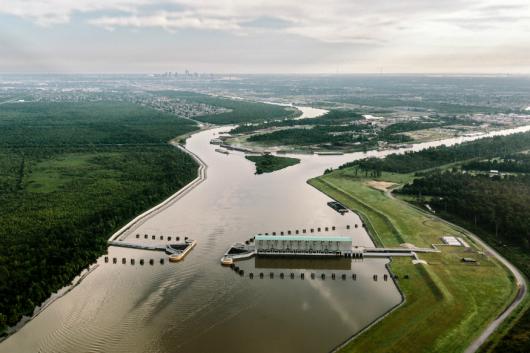And there appear to be no shortage of idiots.
The $119 Billion Sea Wall That Could Defend New York … or Not

An aerial view of the New Orleans Drainage System’s Gulf Intracoastal West Closure Complex, which includes a navigable floodgate, sluice gates and an earthern levee, in Belle Chasse, Louisiana, on June 10, 2015. (William Widmer/The New York Times)
A proposal for a six-mile-long barrier to protect New York City from floodwaters during fierce storms like Sandy has alarmed many experts who say it is an oversimplified, myopic concept that could even make things worse.
- New York Times New York
- Last Updated: January 18, 2020, 2:36 PM IST
The gates swing shut. A 6-mile-long wall blocks the deluge, saving property and lives.
The giant barrier is the largest of five options the Army Corps of Engineers is studying to protect the New York area as storms become more frequent, and destructive, on a warming Earth.
The proposals have sparked fierce debate as New York, like other coastal cities, grapples with the broader question of how and to what degree it must transform its landscape and lifestyle to survive rising seas.
Those who support a barrier miles from Manhattan’s coast — one in the outer New York Harbor, out of sight from many residents and tourists — say it would be the best solution for protecting the most people, properties and landmarks, including the Statue of Liberty, from a storm surge swelling the East and Hudson rivers, without cutting off the city from its waterfront.
Catherine McVay Hughes, who led the community board in lower Manhattan during Hurricane Sandy, supports the outer harbor barrier because, she said, protection measures built solely on the coastlines, yet high enough to ward off the biggest floods, would be unsightly.
“Do we want a 20- or 30-foot-wall between Battery Park and the river?” she asked.
Advocates like McVay Hughes are attracted to the prospect of an enormous barrier that would protect much of the region. They also say that the use of locally tailored, onshore solutions alone, like berms, wetlands restoration and raised parks, would likely benefit wealthy areas first, not the low-income communities that suffered disproportionately from Sandy in 2012.
But despite its boldness, a barrier like this has alarmed many resilience planning and environmental experts, who say it is an oversimplified, myopic concept that does not attempt to address several major climate threats and could even make things worse.
The Corps’ barrier designs aim to address only storm surges. They would not counter two other climate-related threats — flooding from high tides and storm runoff — and they could trap sewage and toxins, which would threaten the nascent ecological revival of New York’s waterways.
The Corps estimates the wall to cost $119 billion, and it is unclear if the city, New York state, New Jersey and Congress will agree to jointly fund the project, which would take 25 years to build. Even if construction went smoothly, opponents say, the barrier could be obsolete within decades because, they say, the Corps’ estimates of future sea levels are too low.
“These sea gates will not be able to protect communities from flooding caused by rising tides and rising sea levels, and once they’re built, that’s it,” said Scott M. Stringer, the New York City comptroller, who in a recent letter to the Corps urged them to reshape the plans, calling the barrier options risky. “We’re not going to get the money again.”
The Corps says that its designs can be modified for higher seas and emphasizes that it is not wedded to any of the five options it is studying. Beside the outer harbor wall, there are four less massive proposals. Three involve different combinations of smaller sea walls at the mouths of various New York City waterways, and a final option includes shore-based measures only.
“If there’s an economically viable and ecologically sound solution that can reduce risks to New York and New Jersey, we should put that forward,” said Clifford S. Jones III, planning chief for the Corps’ New York district.
But there is another potential sticking point, according to Kimberly Ong, a senior attorney at the Natural Resources Defense Council, an influential environmental group. When it rains, New York’s stormwater and sewage system can back up and push waste into waterways.
A big barrier, Ong said, could trap that sludge closer to shore.
“We’d essentially be sitting in a bathtub of our own excrement,” she said.
Environmental advocates also say that any barriers, even when open on days without major storms, would change the natural flow of sediment and salt in the Hudson River estuary, affecting migration and feeding of marine life.
The conundrum on how to best protect New York reflects the challenges other major cities face in deciding how to respond to climate change. Coastal areas not only power much of the world’s economy, they also house 40% of its population.
New York City, New York state and New Jersey would all have to approve any barrier and foot 35% of the bill. The city and two states, which are consulting with the Army Corps, have yet to take official positions on a solution. Congress must agree to fund the remaining 65% of the cost.
The barrier debate comes as New York City is still struggling to respond to Sandy and the larger need to carefully reshape an entire region’s infrastructure to adapt to climate change. In the more than seven years since the storm killed 72 people and caused $62 billion in damage, agencies have spent just 54% of the $14.7 billion allocated by the federal government to help the city recover and prepare for new storms.
Still, no one is sure if the most ambitious and costly engineering solutions will work in the long run and what their effects could be. A 5-mile-long, swinging-gate structure in the Netherlands, built after a deadly storm in the 1950s, has both curbed flooding and caused environmental damage, changing the ecology of estuaries and marshlands, as has the Thames Barrier in London.
In New Orleans, levees that last year the Corps spent $14 billion to upgrade are sinking and are projected to be inadequate within four years.
Boston recently studied a sea barrier but rejected it in favor of a mix of onshore measures like retractable flood walls and wetland terraces. Russia, however, has credited a nearly 15-mile barrier, completed in 2010, with protecting St. Petersburg from a catastrophic storm a year later.
In New York, plans to protect stretches of lower Manhattan have repeatedly stalled because of disagreements over design. And to the chagrin of Stringer, local officials and residents on both sides of the barrier debate, there is still no comprehensive plan to defend the rest of the city’s 520-mile coastline from flood threats.
The Corps’ recent decision to focus on storms, and not rising seas, ran afoul of New York officials, including the City Council, which adopted a resolution last year asking the agency to reframe the project to include preventing flooding from rising seas. As Stringer’s letter notes, the agency’s study is relying on a sea-level rise of 1.8 feet by 2100.
The New York City Panel on Climate Change says that number could be 4.17 feet by century’s end — with a worst-case scenario of 9 feet.
Congress — where Republican leaders have not embraced the scientific consensus that climate change requires urgent action — must approve any project for the New York region, and critics contend that was a factor in the Corps’ decision.
The agency, which has received several thousand comments objecting to various aspects of the proposals, has promised to hold more public hearings and has emphasized that any project would undergo rigorous environmental modeling before being presented to Congress no earlier than 2022.
It has also acknowledged some problems with the plan that includes the biggest outer harbor barrier, which would be paired with a second barrier between the Long Island Sound and East River. Experts have warned that those barricades could send storm surges ricocheting toward Long Island and northern Queens. At a hearing in Long Island in the fall, the audience applauded when Jones, the Corps official, noted those concerns.
The quickest and least costly option the Corps is considering, a $14 billion project taking nine years, includes only shore-based measures.
In an interview, Jones said a cost-benefit analysis favored what the agency called middle-ground options. These, costing $43 billion to $47 billion, propose multiple smaller barriers, across, for example, the Narrows between Staten Island and Brooklyn, and the entrances to Jamaica Bay, Newtown Creek and the Gowanus Canal.
In a paper written with Stony Brook University oceanographer Malcolm Bowman and others, McVay Hughes, the former community board leader, argued for “a tiered approach,” including the giant outer barrier and shore-based measures aimed at protecting against sea-level rise.
The paper called the outer barrier the fairest solution because a district-by-district approach would likely give priority to wealthy and commercial areas at the expense of less affluent neighborhoods.
But Annel Hernandez, associate director of the New York City Environmental Justice Alliance, said none of the Corps proposals addressed the problems increasingly plaguing low-lying, working-class communities: polluted stormwater runoff and the increasing frequency of floods from high tides, known as “sunny-day” flooding.
“Instead of committing to one multibillion-dollar project, we can have more ecologically grounded shoreline protection across the city,” said Hernandez, who works closely with a South Bronx community development organization called the Point.
Paul Gallay, who heads Riverkeeper, an advocacy group for the Hudson, said: “Barriers are a shiny object, a silver-bullet fix luring us away from where need to go. The danger of one big wall is that if it fails, we’re all in danger. We need layered solutions.”
